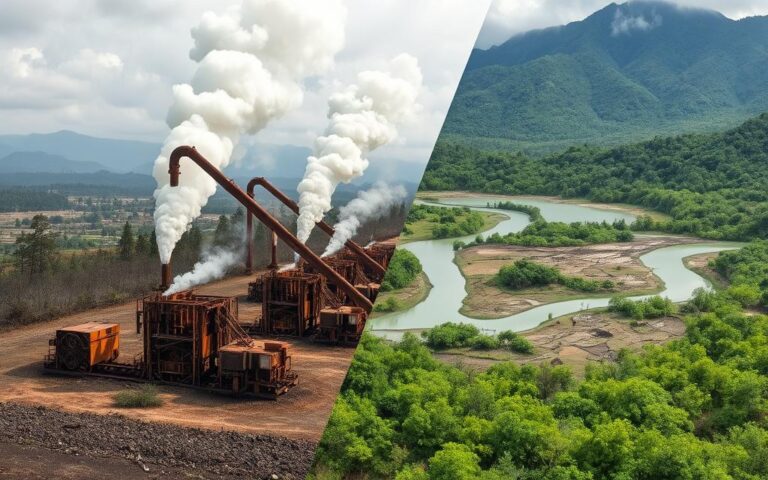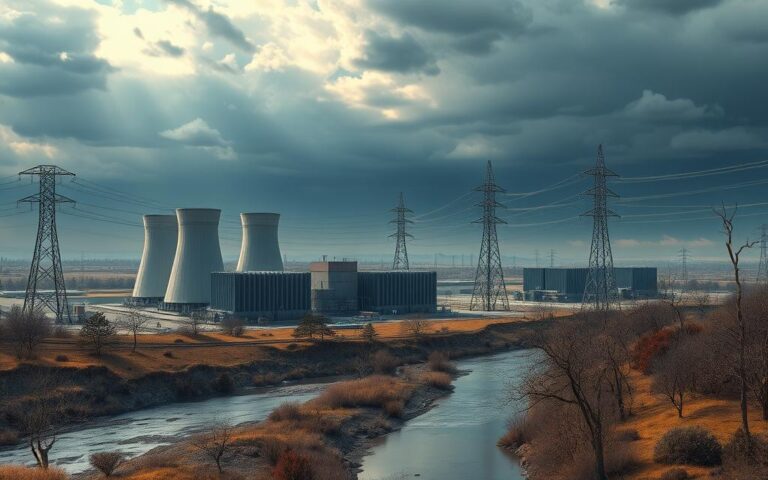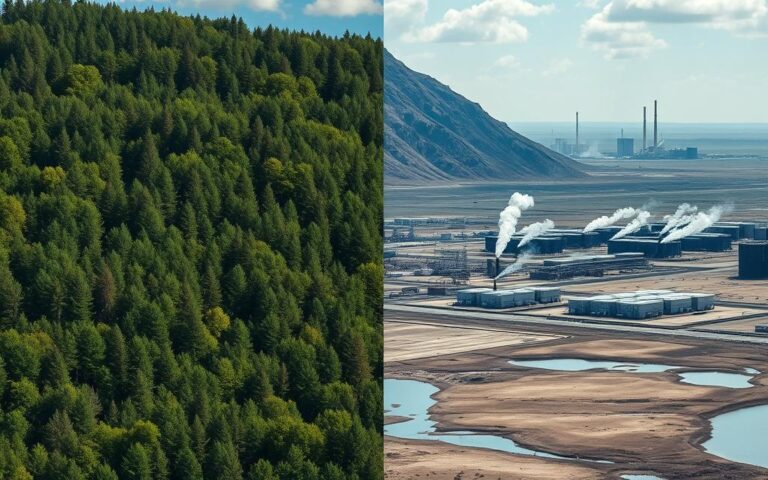How Crypto Mining Damages the Environment: Facts and Solutions
Cryptocurrency’s growth over the last decade has been huge. But this boom has caused big environmental problems. United Nations scientists say crypto mining, especially Bitcoin, creates a lot of pollution. It’s as bad as burning 84 billion pounds of coal. We need to seriously think about how much energy this uses.
In just a year, 2020 to 2021, Bitcoin mining used 173.42 Terawatt hours of electricity. This makes it the 27th biggest user of power worldwide. This usage creates a huge water footprint, enough to fill 660,000 Olympic pools. To make up for the pollution, we would need to plant 3.9 billion trees. It’s clear we have to find a better way.
It’s critical to find sustainable ways to mine crypto. We need to balance digital currency growth with eco-friendly practices. Understanding the environmental cost of crypto mining is the first step. This will help the industry move towards less harmful methods. For more on reducing tech waste, check out this link on e-waste impact reduction.
The Environmental Footprint of Crypto Mining
Cryptocurrencies are becoming more popular but they cause big ecological problems. We need to look closely at issues like Bitcoin’s energy use, carbon emissions, and how it affects water and land. These factors show the tough situation we’re in when it comes to keeping the environment safe.
Understanding Energy Consumption
Bitcoin mining uses a lot of energy, about 95.5 TWh each year. This is nearly 0.4% of the electricity the whole world uses. It uses as much power as some countries, fitting between Belgium and the Netherlands. Though a lot of this energy is from burning fossil fuels, some comes from renewables. This could help make things better in the future.
Carbon Emissions from Bitcoin Mining
Bitcoin mining’s carbon emissions are very high, about 65 million tonnes a year. This is 0.2% of global emissions, the same as a whole country like Greece. This shows we need to mine in a way that’s cleaner. A big part of the problem is that miners often use dirty energy, especially in places like China and Kazakhstan.
The Water and Land Footprints
Bitcoin mining also uses lots of water and land. It needs enough water for over 300 million people in some African areas. Plus, it covers more land than a big city like Los Angeles. These facts show how mining can harm our planet. To understand more, read about Bitcoin’s environmental impacts.
Does Crypto Mining Damage the Environment?
The topic of how crypto mining impacts the environment is getting more attention. It’s especially significant when we compare it to traditional banking. The evidence shows a clear difference. Mining for cryptocurrencies uses a lot of energy, which often comes from fossil fuels. This leads to harmful emissions.
Comparative Analysis with Traditional Banking
Crypto mining uses more energy than the whole banking sector, yet it handles far less money. For instance, Bitcoin mining emits as much CO2 as Greece, reaching about 65.4 megatonnes a year. This high level of energy use points out the big environmental cost. We need to think about eco-friendly practices in finance quickly.
Global Impacts of Major Mining Countries
The biggest Bitcoin mining countries, like the USA and China, have a big part in this. Their Bitcoin mining countries impact is huge because they often use fossil fuels. The top ten mining countries together cause 92–94% of Bitcoin’s total carbon, water, and land footprints. As their mining grows, finding green solutions becomes even more critical.

We must look for different ways of doing things because of these facts. If Bitcoin mining starts using renewable energy, it could cause less harm. Financial groups also need to act. They should work to lessen the environmental impact of their crypto activities. It might take new rules and creative ideas to reduce crypto mining’s harm.
Addressing the environmental impact of cryptocurrency mining is key to growing sustainably.
The Role of Fossil Fuels in Crypto Mining
Bitcoin mining heavily depends on fossil fuels. This raises worries about its environmental effects. Non-renewable energy forms the backbone of Bitcoin’s energy use. This makes it hard to cut down on greenhouse gases. It’s vital to know how energy is used in crypto mining to judge its environmental footprint.
Current Energy Mix in Bitcoin Mining
Most Bitcoin mining relies on non-renewable energy, with a large 61% using it. Coal, a major energy source here, is a big cause of carbon emissions. In 2020, the energy used for Bitcoin mining was more than what countries like Austria and Portugal used. The energy Bitcoin needs grows as its market value does. This shows a clear link between Bitcoin’s worth and its energy use.
Coal Dependency and Its Consequences
Using coal for Bitcoin mining harms the environment greatly. For every $1 the Bitcoin market grows, about $0.49 in climate damage occurs. Bitcoin’s environmental harm is on par with that from beef and crude oil. A Bitcoin mined in 2021 emitted 126 times the carbon dioxide of one mined in 2018. This shows the industry’s growing environmental impact.
The heavy use of fossil fuels in Bitcoin mining is troubling. It raises serious concerns about its reliance on coal and the environmental harm it causes. The increasing energy needs and carbon emissions call for big changes in the industry.
Innovative Solutions for Sustainable Mining
The journey towards sustainable crypto mining is lit up with innovative methods. This mainly includes moving to renewable energy sources. Currently, Bitcoin mining uses a lot of fossil fuels. These fuels add to carbon emissions and worsen global warming. However, areas using hydropower for Bitcoin have seen good outcomes, making up about 16% of its energy use. To boost this, mining operations should team up to create new renewable energy. This will foster a sustainable and responsible mining future.
Transitioning to Renewable Energy
Using renewable energy in crypto is key to lessening its environmental impact. Efforts are being made to use solar, wind, and hydropower. Still, there’s a long way to go. Focusing on decentralised mining can spread out energy use. It will also encourage innovation and competition, leading to better methods. The research into less energy-heavy processes like proof-of-stake shows promise for the future.
Technological Advancements in Mining Processes
Alongside renewable energy, tech improvements are crucial. New mining hardware aims to use less energy but keep the same power. Also, using blockchain for carbon-offset schemes helps show true sustainability efforts, making the industry more open. By using these tech changes, the crypto world can aim for a more sustainable future.
Government Regulations and Policies
Government rules on crypto mining can help meet environmental goals. Enforcing sustainable practices and reducing the ecological impact of crypto operations can guide the industry. Zoning laws and oversight on energy use are important steps here. Together, these measures could marry crypto growth with the need for environmental care. They offer a path to a thriving technology that respects our planet.
FAQ
What is the environmental impact of crypto mining?
Crypto mining, including Bitcoin, greatly harms the environment. It’s like burning 84 billion pounds of coal. The energy used is more than some countries’ total. It also uses as much water as 660,000 Olympic pools.
How does Bitcoin mining contribute to carbon emissions?
Bitcoin mining releases about 85.89 million tonnes of CO2 yearly. About 67% of its energy comes from fossil fuels. This reliance increases carbon emissions significantly.
What are the water and land footprints of Bitcoin mining?
Bitcoin mining’s water use could meet the needs of 300 million people in rural Africa. It also uses land bigger than Los Angeles. This shows its big impact on land and water use.
Is crypto mining more environmentally damaging than traditional banking?
Indeed, crypto mining uses double the energy of global banking but handles far less money. This makes it much worse for the environment than traditional banking.
Which countries are the largest contributors to Bitcoin mining’s environmental impacts?
The USA and China are the top Bitcoin mining countries, making up most of the global mining. They mostly use fossil fuels, which increases environmental damage.
What is the current energy mix used in Bitcoin mining?
Bitcoin mining mainly uses coal and natural gas, with some nuclear power. Renewables like hydropower, solar, and wind are also used but less so. This mix raises sustainability concerns.
How can we achieve sustainable crypto mining solutions?
By using renewable energy, building new energy systems, and improving technology, we can mine more cleanly. Laws and controls on energy use can also help reduce mining’s environmental impact.















